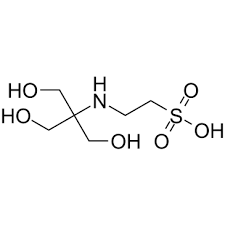TES

Product Description
N-[Tris(hydroxymethyl)methyl]-2-aminoethanesulfonic acid, commonly known as TES, is a chemical compound used in various laboratory and biotechnological applications.
Product:
TES
CAS:
7365-44-8
Synonym:
N-[Tris(hydroxymethyl)methyl]-2-aminoethanesulfonic acid; 2-[(2-Hydroxy-1,1-bis(hydroxymethyl)ethyl)amino]ethanesulfonic acid
Structure:

Typical Characteristics
Appearance
White powder
Density
1.260 g/cm3
Melting point
216-218°C
Molecular Weight
229.25
Odor
Odorless
Purity
≥99%
Refractive index
1.550
Uses, Applications & Markets
Key applications
Markets
get a quote



TES used in many
industry applications
N-[Tris(hydroxymethyl)methyl]-2-aminoethanesulfonic acid, commonly known as TES, is a chemical compound used in various laboratory and biotechnological applications. Here's a list of some of its uses:
- Buffer Solution: TES is commonly used as a buffering agent in biological and biochemical experiments. It helps maintain a stable pH in solutions, particularly in the physiological pH range, making it suitable for cell culture media and enzyme assays.
- Electrophoresis: TES buffer is used in gel electrophoresis techniques for the separation and analysis of nucleic acids and proteins. It provides the appropriate pH conditions for efficient electrophoretic mobility of biomolecules.
- Enzyme Studies: TES buffer is employed in enzymology studies to maintain optimal pH conditions for enzyme activity. It can be used in kinetic assays, enzyme kinetics, and enzyme purification protocols.
- Cell Culture: TES buffer is used in cell culture media to maintain the pH of the growth environment for various cell types. It provides a stable pH environment that mimics physiological conditions, promoting cell viability and growth.
- PCR (Polymerase Chain Reaction): TES buffer is sometimes used in PCR reactions as a component of the reaction mix. It helps maintain the pH stability during the thermal cycling process, ensuring efficient amplification of DNA targets.
- Protein Crystallization: TES buffer is used in protein crystallization experiments as a crystallization agent or as a component of crystallization buffers. It provides suitable pH conditions and ionic strength for protein crystallization and crystal growth.
- Biophysical Studies: TES buffer is employed in various biophysical studies, such as spectroscopy, calorimetry, and structural biology. It provides a stable pH environment for investigating the structure, stability, and interactions of biomolecules.
- Chemical Synthesis: TES can also be used as a reagent or solvent in organic synthesis reactions. Its mild properties and water solubility make it suitable for certain chemical transformations and as a reaction medium.